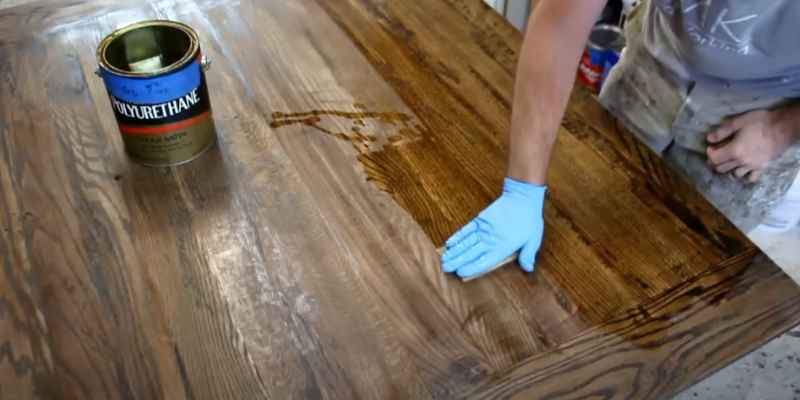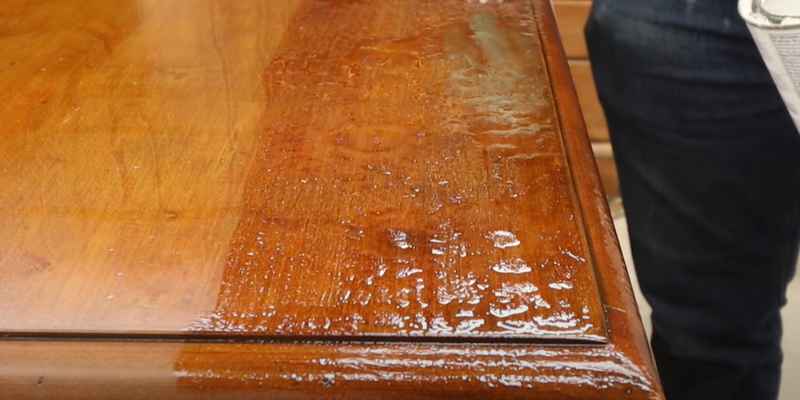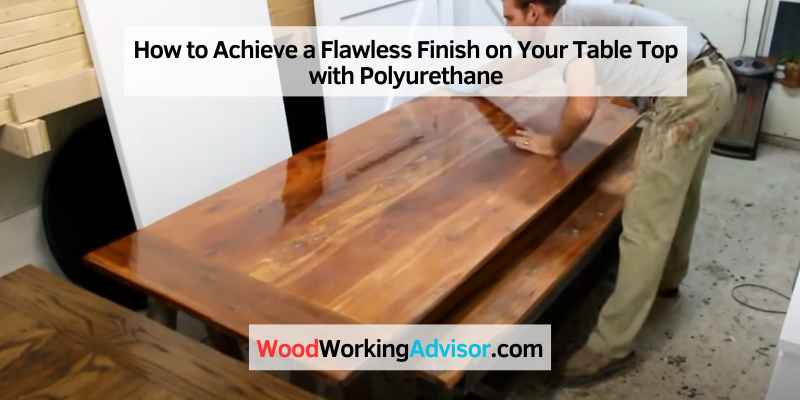To finish a table top with polyurethane, sand the surface, wipe away all dust, apply a coat of polyurethane, let it dry, lightly sand, wipe away dust again, and apply additional coats as desired. A beautifully finished table top can enhance the overall appearance and durability of any table.
Whether you have a new piece of furniture to finish or want to revive an old table, applying a polyurethane finish can provide a sleek and protective surface. The process of finishing a table top with polyurethane requires a few simple steps, but the result is a durable and long-lasting finish that will protect your table from moisture, stains, and scratches.
We will walk you through the process of finishing a table top with polyurethane, providing clear instructions to help you achieve a professional-looking finish. So, let’s dive in and learn how to finish a table top with polyurethane.
Choosing The Right Polyurethane
Choosing the right polyurethane for finishing a table top is essential for achieving a professional and durable result. Consider factors such as the desired sheen, application method, and durability needs to make an informed decision.
When it comes to finishing a table top with polyurethane, one of the most important decisions you’ll face is choosing the right type of polyurethane. The type of polyurethane you choose will not only determine the durability and protection of the finish, but also affect the overall appearance and maintenance of your table. In this section, we’ll explore the different options available to help you make an informed decision.
Water-based Or Oil-based
One of the first decisions you’ll need to make is whether to use water-based or oil-based polyurethane. Both options have their own advantages and considerations.
Water-Based Polyurethane
|
Oil-Based Polyurethane
|
Gloss, Satin, Or Matte Finish
Once you’ve decided on the type of polyurethane, you’ll need to choose the desired finish. Polyurethane finishes are available in gloss, satin, and matte options, each offering its own unique characteristics.
- Gloss Finish: Provides a high-shine, reflective surface that enhances the natural beauty and grain of the wood. Offers a durable and protective finish but may highlight imperfections.
- Satin Finish: Offers a soft, lustrous sheen that is less reflective than gloss. Provides a balance between shine and hiding imperfections, making it a popular choice for many table tops.
- Matte Finish: Provides a low-sheen, velvety surface that minimizes glare and emphasizes a natural look. Hides imperfections well but may lack the same level of durability as gloss or satin finishes.
Consider the desired look, the amount of use your table will receive, and personal preference when choosing the finish. Each option will give your table a different appearance, so make sure to select the one that aligns with your vision.
Preparing The Table Surface
To finish a table top with polyurethane, start by preparing the surface by sanding it down and removing any existing finishes. Apply a coat of polyurethane, let it dry, and sand lightly between coats for a smooth, durable finish.
Preparing the table surface is an essential step to ensure a flawless and durable polyurethane finish. By cleaning the surface, sanding, and smoothing it appropriately, you create the perfect foundation for the polyurethane to adhere to. Let’s dive into each of these steps in detail.
Cleaning The Surface
Before beginning any refinishing project, it is crucial to clean the table surface thoroughly. A clean surface ensures that the polyurethane adheres properly and provides a smooth and even finish. Here’s a simple process to follow:
- Start by removing any loose dirt or debris from the table surface using a soft brush or cloth.
- Next, wipe down the surface with a damp cloth or sponge to remove any remaining dirt or grime. Ensure that you use a mild detergent or wood cleaner that is safe for the type of wood you are working with.
- Rinse the surface with clean water to remove any detergent residue.
- Allow the table to dry completely before moving on to the next step.
Sanding And Smoothing
Sanding the table surface is crucial as it helps to remove any unevenness, imperfections, or previous finishes. This step ensures that the polyurethane adheres properly and provides a smooth and flawless finish. Follow these steps to sand and smooth the table surface effectively:
- Start by choosing the appropriate sandpaper grit for the initial sanding. If the surface has a previous finish or rough spots, begin with medium-grit sandpaper (around 120 grit). If the surface is relatively smooth, you can start with a finer grit sandpaper (around 220 grit).
- Working in the direction of the wood grain, sand the entire table surface using smooth and even strokes. Avoid applying excessive pressure, as it can result in uneven sanding.
- After completing the initial sanding, switch to a finer grit sandpaper and repeat the process. This step ensures that the surface is even and ready for the polyurethane.
- Clean the table surface thoroughly to remove any sanding dust. Use a soft brush or cloth, and make sure there is no residue left on the surface.
Following these steps will ensure that your table surface is properly prepared for the application of polyurethane. Cleaning the surface removes any dirt or contaminants, while sanding and smoothing create a smooth and even foundation for the finish. Be thorough and attentive while preparing the table surface to achieve a stunning polyurethane finish.

Applying The Polyurethane
When it comes to finishing a table top, applying polyurethane is a popular choice. This durable and long-lasting coating provides a protective layer that enhances the natural beauty of the wood. To achieve a smooth and flawless finish, it’s essential to follow the right steps. Here, we’ll guide you through the process of applying polyurethane, ensuring your table top looks its best.
Using A Brush Or Foam Applicator
To apply polyurethane, you have two main options: using a brush or a foam applicator. Both methods have their own advantages, so it’s a matter of personal preference.
Brush: Using a brush allows for better control and coverage, especially on larger surfaces. Ensure the brush is high-quality and suitable for applying polyurethane. Synthetic bristle brushes are a popular choice, as they don’t absorb the finish.
Foam Applicator: Foam applicators are great for smaller projects or when you want to avoid brush marks. They offer a smooth and even application. Use a high-density foam applicator to achieve the best results.
Applying Thin Coats
When applying polyurethane, it’s crucial to apply thin coats. This ensures that each layer dries properly and minimizes the risk of drips and bubbles. Thick coats can take longer to dry and may result in an uneven finish.
Start with a light sanding: Before applying the first coat, lightly sand the surface with fine-grit sandpaper to create a smooth and even surface. Wipe away any dust or debris with a clean cloth.
Apply the first coat: Dip your brush or foam applicator into the polyurethane, and begin applying it in long, even strokes, following the wood grain. Work in small sections to ensure the coat is applied evenly. Let it dry according to the manufacturer’s instructions.
Sand between coats: Once the first coat has dried, lightly sand the surface with fine-grit sandpaper. This helps to remove any imperfections and creates a better surface for the next coat to adhere to. Wipe away any dust before applying the next coat.
Repeat the process: Continue applying thin coats, sanding between each coat, until you achieve the desired level of smoothness and protection. Most finishes require at least two or three coats for optimal results.
Allowing Drying Time
Polyurethane requires sufficient drying time to fully cure and harden. It’s crucial to follow the manufacturer’s instructions for drying times, as they can vary depending on the product and environmental conditions.
Avoid premature use: Don’t rush to use your table top before the finish has fully dried. Premature use may result in damage to the surface or a less durable finish. Be patient and allow the recommended drying time.
Protect the surface: While the polyurethane is drying, ensure the table top is kept in a clean and dust-free environment. Place it on a flat and level surface to prevent any damage or uneven drying.
Optimal curing: After the recommended drying time, the polyurethane should be cured enough for regular use. However, it’s worth noting that full curing can take up to a month, so avoid placing heavy objects or exposing the table top to excessive heat or moisture during this period.
By following these steps and taking the necessary precautions, you can finish your table top with polyurethane like a pro. The result will be a beautifully protected surface that will withstand daily use without compromising its natural appeal.
Sanding Between Coats
When it comes to finishing a table top with polyurethane, sanding between coats plays a crucial role in achieving a smooth and flawless finish. Sanding between coats helps to remove any imperfections, such as dust or brush strokes, and creates a surface that is perfect for the next application of polyurethane.
Using Fine Grit Sandpaper
One of the key steps in sanding between coats is to use fine grit sandpaper. Fine grit sandpaper, typically ranging from 220 to 400 grit, is ideal for gently removing any roughness or inconsistencies without damaging the previous layer of polyurethane.
Sanding with fine grit sandpaper helps to smooth out the finish and create a level surface for the next coat of polyurethane. It is important to note that using a coarser grit sandpaper may result in scratches or visible marks on the table top, so it’s best to stick to fine grit sandpaper.
Removing Dust
Before sanding between coats, it is crucial to remove any dust or debris that may have accumulated on the surface. Dust particles can easily become trapped in the polyurethane, resulting in a bumpy or uneven finish. To ensure a smooth and flawless finish, follow these steps to remove dust:
- Use a soft, lint-free cloth or a tack cloth to gently wipe the table top, removing any loose dust or particles.
- Carefully inspect the surface to ensure all dust has been removed.
- If necessary, use a slightly damp cloth to wipe away any stubborn or hard-to-reach dust.
By thoroughly removing dust before sanding between coats, you can ensure that the polyurethane adheres evenly and creates a beautiful, professional-looking finish.
Finishing Touches
When it comes to finishing a table top with polyurethane, the final steps are crucial to achieving a smooth and durable finish. In this section, we will focus on the finishing touches that will elevate your table top to the next level. Buffing and polishing are important steps to enhance the shine and smoothness of the polyurethane coating. Additionally, we will discuss how to add more coats if desired, allowing you to customize the level of protection and sheen for your table top.
Buffing And Polishing
Buffing and polishing are simple yet effective techniques that can make a significant difference in the final appearance of your table top. These steps help remove any imperfections and create a smooth, glossy finish.
Here’s how to buff and polish your table top:
- Start by sanding the surface with a fine-grit sandpaper to remove any dust or roughness.
- Next, use a soft cloth or a polishing pad attached to a power buffer to apply a small amount of polishing compound to the table top.
- In a circular motion, gently buff the surface, being careful not to apply too much pressure.
- Continue buffing until the polyurethane coating shines and feels smooth to the touch.
- Finally, wipe away any excess polishing compound with a clean cloth.
Adding More Coats If Desired
If you are looking to achieve a higher level of durability or a deeper shine, you can add more coats of polyurethane to your table top. This allows you to customize the final look and feel of the finish.
Here’s how to add more coats:
- Begin by lightly sanding the existing polyurethane surface with a fine-grit sandpaper. This step helps the new coat adhere properly.
- Remove any dust or debris from the surface using a tack cloth.
- Apply another thin coat of polyurethane, following the same application technique as before.
- Allow the new coat to dry completely according to the manufacturer’s instructions.
- If desired, repeat the process for additional coats, always sanding between each layer.
Remember to always work in a well-ventilated area, and follow the manufacturer’s instructions for proper application and drying times. By taking these finishing touches into consideration, you can achieve a professional-looking finish that enhances the beauty and longevity of your table top.

Frequently Asked Questions For How To Finish A Table Top With Polyurethane
How Do I Get A Smooth Finish With Polyurethane On A Table Top?
To achieve a smooth finish with polyurethane on a table top, follow these guidelines:
1. Prepare the surface by sanding it thoroughly.
2. Apply a coat of polyurethane using a high-quality brush or sprayer.
3. Allow the first coat to dry completely, then lightly sand the surface.
4. Apply subsequent coats, sanding lightly between each one.
5. Finish by sanding and applying a final coat for a smooth and glossy appearance. Follow these steps for a flawless finish on your table top.
What Is The Best Applicator For Polyurethane On Table Top?
The best applicator for polyurethane on a table top is a high-quality brush.
How Many Coats Of Polyurethane Should You Put On A Table Top?
Apply at least three coats of polyurethane on a table top for optimal protection and durability.
What Happens If You Don T Sand In Between Coats Of Polyurethane?
Failure to sand in between coats of polyurethane can result in a rough and uneven finish. Sanding smooths out imperfections, helps adhesion, and allows for a better bond between coats. Sanding between coats ensures a smooth and professional-looking final result.
Conclusion
To sum up, finishing a table top with polyurethane is a simple yet effective way to protect and enhance its appearance. By following the proper steps and techniques, you can achieve a smooth, durable, and professional-looking finish. Remember to sand between coats, ensure proper ventilation, and apply thin layers for optimal results.
With some patience and attention to detail, your table top will be transformed into a beautiful centerpiece that will last for years to come.


